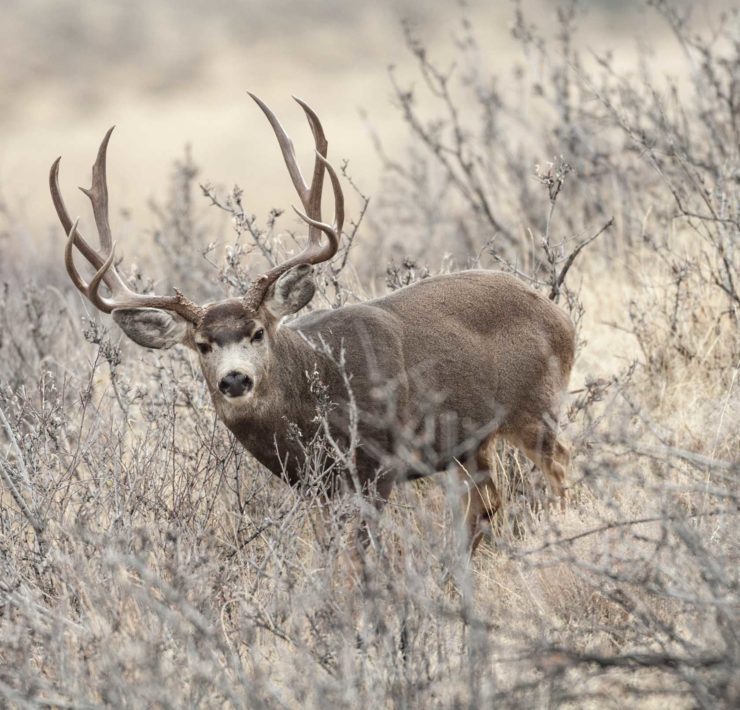“Decoys for Mule Deer?”


“Can they be effective? If so How?
What is a Deer Decoy?
Deer Decoys have been in use for over 6,000 years, since the first humans started creeping up on herds of Bison wearing animal skins. As a species we have always been interested in ways to lure animals closer to us, and increase our chances of hunting success.
Today however, when one hears “Hunting Decoy” most imagine duck or turkey decoys. Plastic molds of critters set in front of a group of hunters to entice these birds to come close enough for a shot. Some more diligent or adventurous whitetail hunters may have some experience with life sized deer decoys in a tree stand style application.
But even this technique can be taboo in some circles. The general theme with whitetail deer is to sit very still, and wait for the unwary deer to pass close enough for a shot. Decoys immediately alert the deer to the idea that something is there. Maybe they will recognize the decoy as a deer and want to come closer to investigate, but just as likely they will see it as a strange object or critter they don’t know who smells funny and bolt.
Mule Deer though?
In recent years more and more hunters have been experimenting with this decoy technique for Mule deer in the South West and the Great Plains. We sat down with four Mule Deer decoy users to gauge their results and garner their advice on the subject.
Hunter One: (Greg in NM)
We sat down with Greg in New Mexico to discuss the effectiveness of mule deer decoys in his neck of the woods. Greg has been using a mule deer full body cut out decoy for the past three seasons, and has found a lot of success in the early season, but not as much after the temperatures drop.
Living in a very arid area Greg prefers to hunt over water. Greg starts by placing a cut out doe mule deer decoy around the water source. He believes this puts other deer in the area at ease, making them more willing to come in to archery range.
“with not much to hide behind in the way of cover, the mule deer decoy I use gives my target bucks something to look at, that definitely isn’t me. I don’t know if they’re coming in because they’re thirsty or if they’re coming in because they’re curious about the decoy, but as long as they’re not looking at me when they come in, that’s a win.”
Hunter 2 (Sarah in SD)
Sarah in South Dakota prefers hunting with her two young boys. They are age 12 and 15 and preferred to sit natural prairie potholes in the early season using a ground blind on the family farm. She employs a full body 3-D Whitetail doe decoy.
Sara believes given her two sons archery skill set, having a life-size 3-D target next to the watering hole helps give them a better estimate of range as well as an idea of where and when they should be shooting deer that come in into the pot hole.
Hunter 3 (Seth in Idaho)
Seth in Southeastern, Idaho tried a mule deer decoy for the first time this past season. Seth is surrounded by potato and dairy farms and thought by carrying a collapsible silhouette style decoy. He could use it to creep closer to mule deer in the flatlands of early season Idaho.
Seth – I have never seen anything work worse. All I kept thinking before the season was the line from Jeremiah Johnson, where bear claw Chris Clapp tells Jeremiah Johnson while they are stalking an elk in the snow.
“elk don’t know how many feet a horse got”
“Well I’ll tell you one thing, the mule deer sure as shit knew, that the mule deer cut out I was hiding behind was more than a regular mule deer.”
“Do NOT Reccomend”
Hunter 4 (Frank Non resident)
Frank-
Last year I went out to eastern Montana along the northern edge of the powder and Yellowstone river confluence. I’ve never hunted in the west before and this was my first mule deer tag. I didn’t know a lot about what I wanted to try, but I thought a collapsible decoy couldn’t hurt so I threw one in the truck.
The first place I set the decoy up was near a low spot by the river early in the morning to see if any deer would come close out of curiosity. I had a few deer early in the morning consistently come through the area. The Mule Deer I saw were not necessarily concerned with the decoy at all, I think they were just in their normal routine, I ended up abandoning the decoy technique and instead glassed up a mule deer on the planes before employing a spot and stock technique to fill my tag.
Conclusion?
Unfortunately the evidence is inconclusive. The good news is we don’t know that it defiantly won’t work. My advice is if you’re out with children or elderly hunters and will be utilizing a standard ground blind location or a series of grunt tube calls in the rut, a decoy might not be a bad option. If you are backpacking 10+ miles into the mountains then you could do without the weight of a decoy.
What did we miss, write in and let us know how decoys work for you.
Good Luck!
Good luck this fall. Send pictures or stories from the field to [email protected] to be featured on our website or in our magazine. If this article, or any of our articles helped you become a better conservation steward, join the mule deer foundation. Click here to join: https://muledeer.org/product-category/membership/
Trevor Hubbs

Trevor is the Communications Manager and Editor for the Mule Deer Foundation and Blacktail Deer Foundation. He grew up hunting and fishing the Ozark Mountains for quail, ducks, and bucks. Now he ventures west for mule deer as often as possible.



